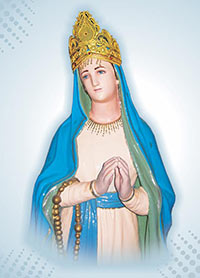
On 11 February 1858, Bernadette Soubirous went with her sisters Toinette and Jeanne
Abadie to collect some firewood and bones in order to buy some bread. After taking
off her shoes and stockings to wade through the water near the Grotto of Massabielle,
she said she heard the sound of two gusts of wind (coups de vent) but the trees
and bushes nearby did not move. A wild rose in a natural niche in the grotto, however,
did move. From the niche, or rather the dark alcove behind it, "came a dazzling
light, and a white figure." She was dressed all in white, apart from the blue belt
fastened around her waist and the golden yellow roses, one on each foot, the colour
of her rosary. Bernadette tried to keep this a secret, but Toinette told her mother.
After parental cross-examination, she and her sister received corporal punishment
for their story.
Three days later, Bernadette returned to the Grotto. She had brought holy water
as a test that the apparition was not of evil provenance, and demanded that if she
were from God, she must stay, but if she were evil, she must go away; however, she
said the vision only inclined her head gratefully when the water was cast and she
made her demands.
Bernadette's companions are said to have become afraid when they saw her in ecstasy.
She remained ecstatic even as they returned to the village. On 18 February, she
spoke of being told by the Lady to return to the Grotto over a period of two weeks.
She quoted the apparition: I promise to make you happy, not in this world, but in
the next.
After that the news spread and her parents took interest. Bernadette was ordered
by her parents to never go there again. It was a shock when people heard her story
as it was so unlikely. She went anyway, and on 24 February, Bernadette related that
the apparition asked for prayer and penitence for the conversion of sinners. The
next day, she said the apparition asked her to dig in the ground and drink from
the spring she found there. This made her disheveled and some of her supporters
were dismayed, but this act revealed the stream that soon became a focal point for
pilgrimages.
Although it was muddy at first, the stream became increasingly clean. As word spread,
this water was given to medical patients of all kinds, and many reports of miraculous
cures followed. Seven of these cures were confirmed as lacking any medical explanations
by Professor Verges in 1860. The first person with a “certified miracle” was a woman
whose right hand had been deformed as a consequence of an accident. Several miracles
turned out to be short-term improvement or even hoaxes, and Church and government
officials became increasingly concerned. The government fenced off the Grotto and
issued stiff penalties for anybody trying to get near the off-limits area. In the
process, Lourdes became a national issue in France, resulting in the intervention
of emperor Napoleon III with an order to reopen the grotto on 4 October 1858. The
Church had decided to stay away from the controversy altogether.
Bernadette, knowing the local area well, managed to visit the barricaded grotto
under cover of darkness. There, on 25 March, she said she was told: "I am the Immaculate
Conception" ("que soy era immaculada concepciou"). On Easter Sunday, 7 April, her
examining doctor stated that Bernadette, in ecstasy, was observed to have held her
hands over a lit candle without sustaining harm. On 16 July, Bernadette went for
the last time to the Grotto. I have never seen her so beautiful before, she reported.
The Church, faced with nationwide questions, decided to institute an investigative
commission on 17 November 1858. On 18 January 1860, the local bishop finally declared
that: The Virgin Mary did appear indeed to Bernadette Soubirous. These events established
the Marian veneration in Lourdes, which together with Fátima, is one of the most
frequented Marian shrines in the world, and to which between 4 and 6 million pilgrims
travel annually.
In 1873 the great "national" French pilgrimages were inaugurated. Three years later
the basilica was consecrated and the statue solemnly crowned. Pope Leo XIII authorized
a special office and a Mass, in commemoration of the apparition, and in 1907 Pius
X extended the observance of this feast to the entire Church; it is now observed
on 11 February.